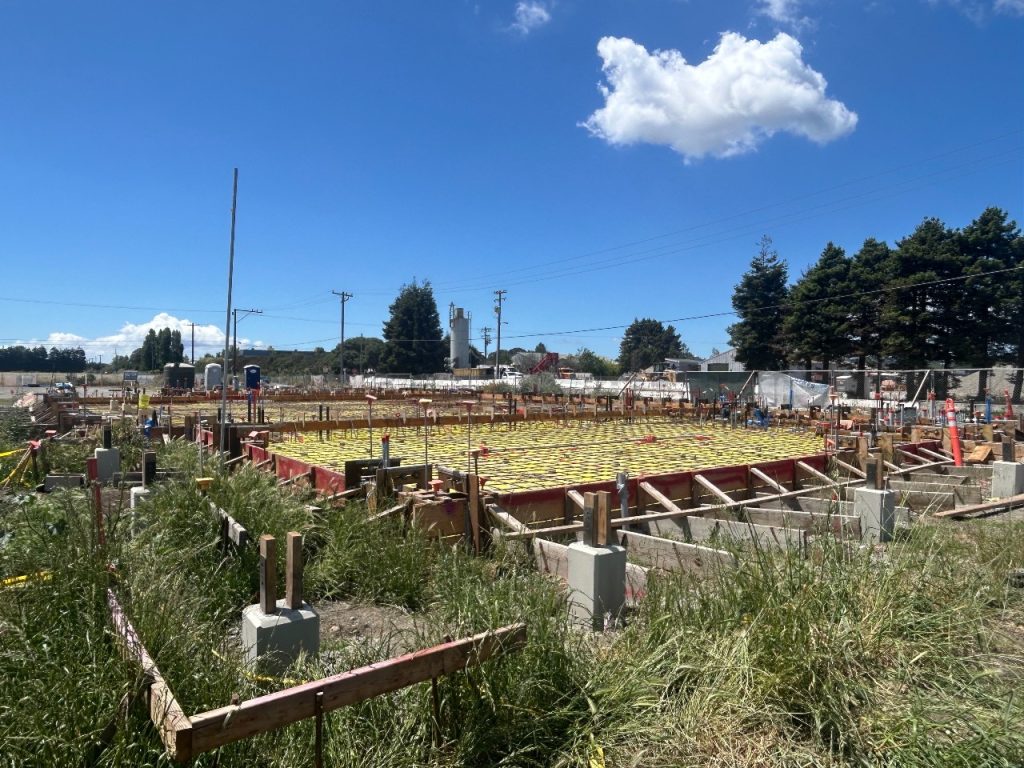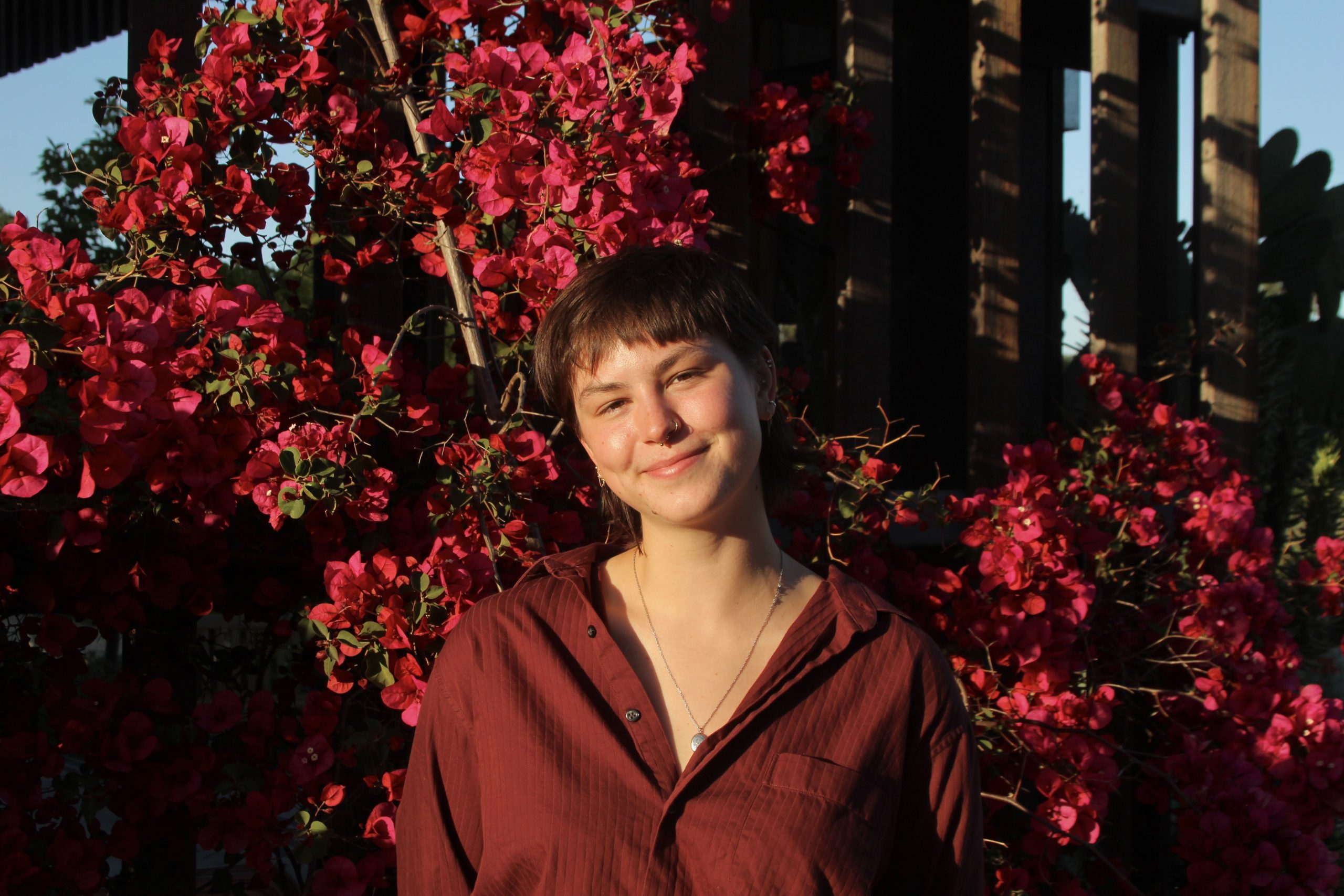
In a desert of warehouses, landfills, and derelict industrial sites, Urban Tilth is an oasis. Stalks of wheat flutter in the breeze. Bees bounce between squash blossoms. A young man dances to the music in his headphones as he buries a hoe in the soil. Marcos “Chito” Floriano greets me with a smile and takes me on a tour through the long rows of crops that sprout with the only fresh produce available in North Richmond, an unincorporated community perched on the northeastern edge of the San Francisco Bay.
Floriano points out kale, chard, tomatoes, zucchinis, pumpkins, beets, and fennel pushing up through the soil. He tells me they have celosias, dahlias, and sunflowers, though he’s not the flower expert. He’s the director of farms and gardens here at the North Richmond Farm, the newest and largest of the organization’s urban farming projects seeking to serve “as the heart of resident-led organizing and opportunity in North Richmond” according to the organization’s website.
On a sunny spring morning, it seems everything on the North Richmond Farm is growing–until we reach what looks like a construction site. Wooden beams and metal crossbars scaffold the bare foundations of three buildings. Urban Tilth had been ahead of schedule on the construction of North Richmond’s first community resilience center, a kind of safe-haven shelter which was to provide clean air and shelter to residents overburdened by pollution from the 3,000-acre Chevron refinery just across the parkway. Floriano gestures to the frozen construction site. “This is what $6 million of that $19 million from the community change grant that was going to come from the EPA into North Richmond was going to fund,” he says. Now that money is gone, and with it a community’s hope that their government is invested in justice for communities like theirs that have suffered generations of environmental racism.
On May 2, despite months of advocacy from residents and local and state representatives, Contra Costa County received word that the EPA had formally terminated a $19 million Community Change Grant that was awarded to North Richmond and the neighboring City of Richmond in January. Now the network of organizations working toward climate resilience in their community have been forced to slow down, pause critical infrastructure projects, and look for other sources of funding. Today they are faced with the same question as environmental groups across the country: what comes next when federal funding is unexpectedly torn away?
In 2022, as a part of the Inflation Reduction Act (IRA), congress authorized $2 billion in federal funding to be allocated to initiatives in disadvantaged communities that aim to “reduce pollution, increase community climate resilience, and build community capacity to address challenges.” Contra Costa County was one of 105 communities to be awarded a Community Change Grant. They proposed to use the $19 million to build green infrastructure, improve mobility options, enhance the energy efficiency of buildings, develop resilience hubs, and fund workforce development programs.
Back on the farm, Floriano and I step up onto a pathway newly paved with red bricks. The history walk, part of the major renovation of the North Richmond Farm, will recount the history of North Richmond from the thousands of years of Ohlone presence on the land, to the civil rights activism of the 20th century, to the environmental justice advocacy ongoing today.
Where the brick pathway widens between the native plant nursery, the watershed workshop, and the composting toilet, we stand in Dr. Henry Clark Plaza in the shade of just-planted saplings. Floriano tells me that Clark dedicated his life to advocating for environmental justice in North Richmond. Born at the end of WWII as oil and chemical companies bought up the newly vacant shipbuilding grounds across the city, Clark recognized from a young age the injustice of the pollution pumped into the air by the Chevron refinery in the city. He lived through many refinery disasters including the 1989 explosion and the 2012 fire, and saw his neighbors killed, hospitalized, and sickened by their environment. Also an active member of the civil rights and Black Power movements, Clark advocated for clean air and water, and access to healthcare for his community.
Urban Tilth honors that legacy not only with names, but by continuing efforts to protect their community in the face of disproportionate pollution. The bulk of the EPA grant was set to fund the construction of the community resilience hub on the North Richmond Farm. The building was to serve as a “breathing center” during climate emergencies like the frequent refinery flare ups, providing clean air and shelter for city residents. It was to be equipped with an advanced air filtration system, solar panels with battery backup, cots, first aid equipment, and showers. In the event of an air pollution event or other climate emergency, dozens of North Richmond residents would be able to shelter safely for up to four days. Outside of climate emergencies, the space was to serve as a center for community gathering, job training, and food and resource distribution. Today, however, its bare foundations serve only as a reminder of a promise broken.
Floriano points out a bright patch of trees and flowers: the Whitney Dotson Garden. Dotson had a passion for the natural world and through dedicated advocacy achieved conservation of a key North Richmond coastal marsh, renamed the Dotson Family Marsh. “They’re true leaders,” Floriano tells me, “and so we wanted to make sure that we were honoring their legacy and naming our spaces after them.”
Today, the Watershed Project carries forward Dotson’s advocacy in North Richmond, facilitating the conservation and appreciation of the bay area watershed. With another portion of the EPA grant, the organization planned to plant hundreds of trees across the community to provide screens against air pollution, and to restore Wildcat creek to reduce flood risk, improve water quality, and preserve a beautiful green space in the center of the city. Juliana Gonzalez, executive director of the Watershed Project hopes that with investment in the project and dedication to conservation that “one day we may be able to go fishing behind the Payless parking lot.”
Dr. Darell Davis of the Community Housing Development Corporation (CHDC) tells me that Wildcat Creek has also served as a living space for hundreds of unhoused North Richmond residents. Community resilience and creek restoration cannot be decoupled from the housing crisis in the city. Parts of the EPA funding were set to go to Rich LAND and CHDC to fund projects to create affordable green housing for the community.
The funding was not aimed at just one goal, but at multilateral resilience, attacking the roots of environmental injustice in the community from all sides. Other portions of the funding were set to go e-bike infrastructure to improve community mobility, green jobs training to attack economic disinvestment, and creation of a grocery store and fresh farmstand to address the food desert in North Richmond.
On March 10, EPA Administrator Lee Zeldin announced that in partnership with DOGE, the EPA would be cancelling more than $2 billion in EPA grants “across nine unnecessary programs.” With no official notice of the change, Contra Costa County found on March 27 that their grant was on the list of the 400 to be cancelled.
North Richmond residents, community organizers, and local and state politicians rallied to demand the release of the funding. On April 21, John Garamendi and Mark DeSaulnier, Contra Costa County’s representatives in the house, sent a letter to Lee Zeldin asking for the return of the funding, and declaring the revocation unlawful “Given the grave nature of these seemingly flagrant violations of federal appropriations law, federal court orders, and EPA’s contract with Contra Costa County, we expect that EPA will fully and quickly reinstate Contra Costa County’s Community Change Grant.” Still, on May 2, the county received word of the formal termination of the grant.
With $19 million suddenly revoked, the community resilience projects were forced to freeze. CHDC is unsure when their new affordable housing projects will be available. The Watershed Project does not know how many trees they will be able to plant, or if Wildcat Creek will ever run clearer. Before they even had them, North Richmond residents have lost e-bikes, community gardens, fresh groceries, and jobs. Next time the Chevron refinery flares or explodes, Urban Tilth will only be able to offer the concrete foundation of a resilience hub–no HVAC system, no backup generator, no walls.
Joanna Griffith, director of real estate development at CHDC, has an ask for the administration: “Come to some of these communities where you have frozen the funds, and see the work that has been done to date, as well as proposed plans for projects, and just see the faces of the people that you’re affecting directly.”
Even without the funding, Davis has hope that the community will find a way to make these critical projects happen. “We’re resilient. Sometimes we get knocked down, and we just find other ways. We’ve got some brilliant minds at work here, and brilliant minds in this community, and we always come together.”
Floriano and I end our tour looking out at seven acres of land that Urban Tilth recently saved from becoming another warehouse. The organization is just beginning to imagine what resources this land could help provide to the community. “We may be seeing a lot of pushback from the administration federally, but if we can localize it, whether it’s statewide or citywide or our county, I think that’s where the true power is, and where we can really have a voice and a say.” In North Richmond, as in so many other overlooked communities, recent funding cuts are a reminder that outside investment is never reliable. And so, like Clark and Dotson and so many activists before them, North Richmond leaders turn to that which cannot be taken from the community–home-grown resilience.

